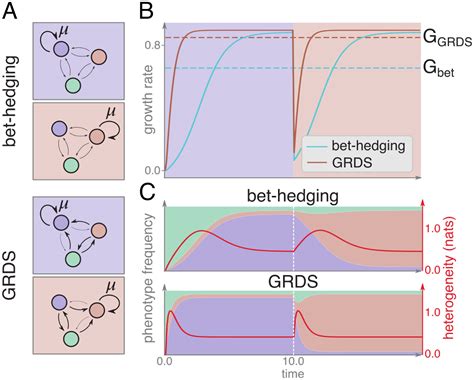Bet-Hedging Bio: Embracing Uncertainty and Maximizing Success
In the unpredictable tapestry of life, organisms have evolved ingenious strategies to navigate uncertainty and optimize their chances of survival. Bet-hedging, a fascinating biological phenomenon, sits at the heart of this adaptive response. It is a risk-averse strategy in which organisms employ multiple strategies or phenotypes to ensure their fitness across a range of environmental conditions.
Understanding the Core Principles
Bet-hedging is a deliberate biological strategy that increases the likelihood of at least one phenotype or strategy succeeding in various unpredictable environments. It is based on the assumption that no single phenotype is universally optimal, and that diversifying investment across multiple options increases the probability of survival.
Bet-Hedging in Practice: Spreading the Risk
An organism may develop diverse phenotypes, such as varying the size or shape of offspring, or altering their reproductive timing. These variations spread the risk across different environmental conditions, maximizing the chances of survival.
For example, in the desert plant Plantago ovata, seeds exhibit a wide range of germination times. Some germinate immediately upon rainfall, even if conditions are harsh. Others delay germination, waiting for more favorable conditions. This bet-hedging strategy ensures that at least some seeds will germinate and thrive, regardless of the uncertainty of rainfall patterns.

Benefits of Bet-Hedging
Bet-hedging offers numerous advantages, including:
-
Increased survival rates: By diversifying fitness outcomes, organisms enhance their ability to survive across a range of environmental conditions.
-
Improved adaptation to changing environments: Bet-hedging enables populations to adapt rapidly to fluctuating environmental conditions, reducing the risk of extinction.
-
Enhanced genetic diversity: By maintaining multiple phenotypes within a population, bet-hedging promotes genetic diversity and reduces the likelihood of genetic bottlenecks.
The Value of Imperfect Information
Bet-hedging is not solely confined to cases of complete environmental uncertainty. Even when organisms possess some knowledge about their surroundings, they may still opt for bet-hedging strategies. Such strategies reduce the risk of relying too heavily on predictions that may prove unreliable.
For instance, the water strider Aquarius remigis varies its egg-laying strategy based on perceived environmental cues. When water levels are high, it lays fewer eggs in each of multiple clutches. This bet-hedging behavior minimizes the risk of losing all its eggs in a single flooding event.

Stories of Bet-Hedging in Action
- The "Jack-of-all-Trades" Damselfish:
The damselfish Abudefduf vaigiensis exhibits a remarkable bet-hedging strategy in its reproduction. It has three distinct reproductive strategies: egg-laying, live-bearing, and hermaphroditism. By employing this diverse approach, the damselfish increases its chances of reproductive success in various environments.
- The Opportunistic Flowering of the Desert Lily:
The desert lily Lilium parryi displays a fascinating bet-hedging behavior in its flowering patterns. It produces two types of flowers: showy flowers that attract pollinators and self-fertile flowers that guarantee seed production even in the absence of pollinators. This strategy ensures that at least some flowers will be pollinated and produce seeds, even in arid environments where pollinator availability is unpredictable.
- The Diversified Dispersal of Tree Seeds:
Trees employ a range of bet-hedging strategies in their seed dispersal. Some produce seeds that are wind-dispersed, while others rely on birds or animals for dispersal. This diversification ensures that at least some seeds will reach suitable germination sites, despite the uncertainty of dispersal mechanisms and environmental conditions.

A Step-by-Step Approach to Bet-Hedging
-
Assess the Environmental Uncertainty: Determine the level of uncertainty in your environment and the range of potential conditions that may occur.
-
Identify Potential Strategies or Phenotypes: Explore various strategies or phenotypes that could be employed to succeed in different environmental conditions.
-
Spread Your Investment: Diversify your efforts across multiple strategies or phenotypes, allocating resources based on the likelihood of success in each scenario.
-
Monitor and Adjust: Continuously observe the environmental conditions and adjust your strategy or phenotype accordingly, maximizing your chances of success.
Pros and Cons of Bet-Hedging
Pros:
- Increased survival rates
- Enhanced adaptation to changing environments
- Reduced risk of losing all resources in a single environmental event
- Promotes genetic diversity within populations
Cons:
- Higher resource allocation may be required to support multiple strategies or phenotypes
- May reduce the efficiency of each specific strategy or phenotype
- May slow down the rate of adaptation in certain scenarios
Frequently Asked Questions
- What is the difference between bet-hedging and risk-aversion?
Bet-hedging and risk-aversion are both strategies that reduce uncertainty, but they differ in their approaches. Risk-aversion typically involves minimizing risk by sticking to a known and reliable strategy. Bet-hedging, on the other hand, involves diversifying investments across multiple strategies to increase the likelihood of success in a range of uncertain environments.
- Can bet-hedging lead to maladaptation?
In some cases, bet-hedging could potentially lead to maladaptation if the environmental conditions change drastically and none of the bet-hedging strategies prove effective. However, the goal of bet-hedging is to reduce the risk of maladaptation by spreading the risk across multiple strategies.
- How does bet-hedging affect genetic diversity?
Bet-hedging promotes
